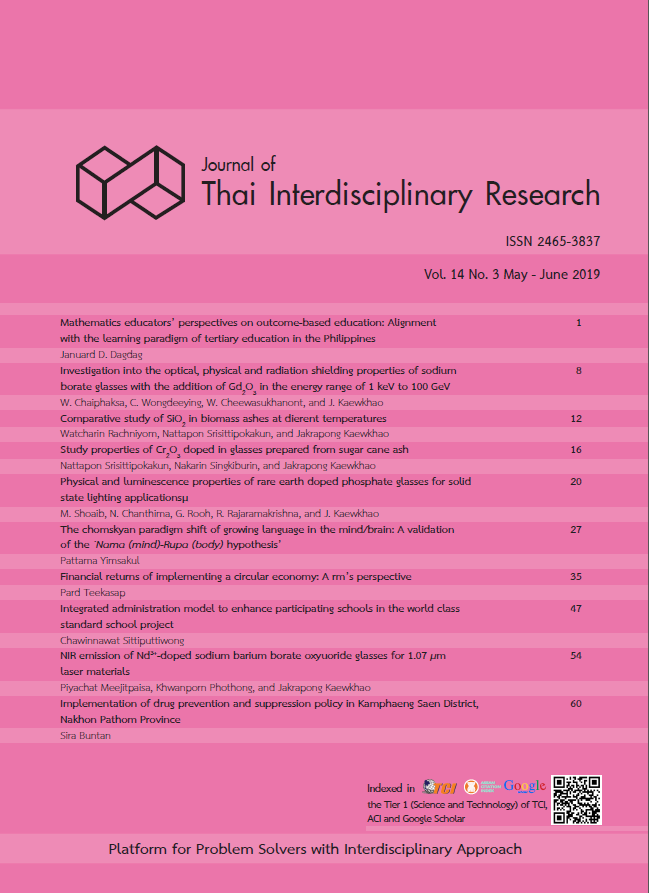Study properties of Cr2O3 doped in glasses prepared from sugar cane ash
Main Article Content
Abstract
The physical and optical properties of glass samples which manufactured using sugar cane ash were investigated. The chemical composition of the sugar cane ash was first analyzed using an X-Ray fluorescence Spectrometer (XRF). The sugar cane ash samples were sintered at dierent temperatures (400 oC, 600 oC, 800 oC and 1000 oC) under the same background conditions. Samples were produced with increasing concentrations of Cr2O3. It was found that the density and refractive index of the glass samples was found to increase as a result of increasing the concentration of Cr2O3 in the sample. The absorption spectra of the samples was measured using a UV-visible light spectrometer. The absorption peak was found to be at 640 nm. This was thought to be due to the transition 4A2g (F) 4T2g (F). This was in turn thought to be due to the Cr3+ ion in octahedral coordination with strong tetragonal distortion. There was another absorption band that was observed at approximately 460 nm. This was thought to be due to the split components of the 6A1g(S)
4T2g (G) transition. Iron, in the Fe2+ state, exists in the glass in equilibrium with the yellow ferric ion (Fe3+). The color coordinate in the glass samples were measured and showed good agreement with the absorption spectra that was observed
Article Details
References
Thailand Sugarcane Beeding Center (TSBC). (2017).
G. C. Cordeiro, K. E. Kurtis, Effect of mechanical processing on sugar cane bagasse ash pozzolanicity, Cement and Concrete Research 97 (2017) 41-49.
N. Srisittipokakun, Y. Ruangtaweep, W. Rachniyom, K. Boonin, J. Kaewkhao, CuO, MnO2 and Fe2O3 doped biomass ash as silica source for glass production in Thailand, Journal Results in Physics, 7 (2017) 3449-3454.
Y. Ruangtaweep, J. Kaewkhao, C. Kedkaew and P. Limsuwan, Investigation of biomass fly ash in Thailand for recycle to glass production, Procedia.Eng. 8 (2011) 58-61.
G. L. Flowerm , M. S. Reddy, G. S. Baskaran, N. Veeraiah, The structural influence of chromium ions in lead gallium phosphate glasses by means of spectroscopic studies. Optical materials 2007;30:357-363.
G.C. Cordeiro, L.M. Tavares, R.D. Toledo Filho, Improved pozzolanic activity of sugar cane bagasse ash by selective grinding and classification, Cement and Concrete Research 89 (2016) 269-275.
A. Awang, S. Ghoshal, M. Sahar, R. Arifin, Gold nanoparticles assisted structural and spectroscopic modification in Er3+ doped zinc sodium tellurite glass, Opt.Mater. 42 (2015) 495–505.
P. Chimalawonga K. Kirdsiri, J. Kaewkha, P. Limsuwand, Investigation on the physical and optical properties of Dy3+ doped soda-lime-silicate glasses, Pro.Eng. 32 (2012) 690 – 698.
N. Sangwaranatee, S. Tuscharoen, H. J. Kim, J.Kaewkhao, Physical and optical properties of bismuth borosilicate glasses from subbituminous fly ash, Mater.Proc. 5 (2018) 15061–1568.
P. Yasaka, P. Mangthong, S. Ruengsri, J. Kaewkhao, Physical,optical and luminescence properties of zinc aluminium barium borate glasses dopedwith chromium oxide, Journal of Thai Interdisciplinary Research. 12 (2017) 23-28.


